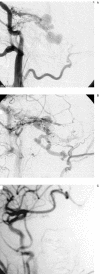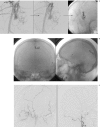Selective transvenous coil embolization of dural arteriovenous fistula. A report of three cases
- PMID: 20566089
- PMCID: PMC3345455
- DOI: 10.1177/15910199070130S118
Selective transvenous coil embolization of dural arteriovenous fistula. A report of three cases
Abstract
We herein report three cases of dural arteriovenous fistula (DAVF) in which the venous outlet immediately adjacent to the fistula was selectively embolized. Case 1: A 69-year-old man presented with a subarachnoid hemorrhage (SAH). Angiography demonstrated a DAVF in the left superior petrous sinus. Case 2: A 59-yearold woman presented with dizziness. Angiography demonstrated a DAVF adjacent to great vein of Galen. The DAVF drained through the great vein of Galen with retrograde leptomeningeal venous drainage (RLVD). The basal vein of Rosenthal was enhanced from the great vein of Galen. Case 3: A 51-year-old man presented with an occipital seizure. Angiography demonstrated a DAVF adjacent to the left side of the superior sagittal sinus with RLVD. All three cases were successfully treated by the selective embolization of the venous outlet immediately adjacent to the fistula. Therefore, selective embolization preserved normal venous return.
Figures






Similar articles
-
Cavernous Sinus Dural Arteriovenous Fistula with an Enhanced Lesion in the Brainstem Mimicking a Malignant Tumor.World Neurosurg. 2020 Aug;140:13-17. doi: 10.1016/j.wneu.2020.04.165. Epub 2020 May 11. World Neurosurg. 2020. PMID: 32407909
-
Spontaneous Resolution of Venous Aneurysms After Transarterial Embolization of a Variant Superior Sagittal Sinus Dural Arteriovenous Fistula: Case Report and Literature Review.Neurologist. 2017 Sep;22(5):186-195. doi: 10.1097/NRL.0000000000000137. Neurologist. 2017. PMID: 28859024 Review.
-
[Evolution of angiographic signs of venous hypertension and clinical signs of intracranial hypertension in intracranial dural arteriovenous fistulas].J Neuroradiol. 1999 Mar;26(1):49-58. J Neuroradiol. 1999. PMID: 10363442 French.
-
Fatal Hemorrhage Immediately after Transvenous Embolization of Transverse-sigmoid Sinus Dural Arteriovenous Fistulas: A Case Report.J Neuroendovasc Ther. 2020;14(8):319-325. doi: 10.5797/jnet.cr.2019-0101. Epub 2020 Jun 5. J Neuroendovasc Ther. 2020. PMID: 37502171 Free PMC article.
-
[A case of cavernous sinus dural arteriovenous fistula presenting with intracranial hemorrhage].No Shinkei Geka. 2011 Jul;39(7):687-92. No Shinkei Geka. 2011. PMID: 21719913 Review. Japanese.
Cited by
-
Non-Sinus Type Dural Arteriovenous Fistula: Others.J Neuroendovasc Ther. 2025;19(1):2023-0023. doi: 10.5797/jnet.ra.2023-0023. Epub 2023 Sep 5. J Neuroendovasc Ther. 2025. PMID: 39958458 Free PMC article. Review.
-
Parasagittal dural arteriovenous fistulas.Interv Neuroradiol. 2024 Dec;30(6):839-845. doi: 10.1177/15910199241286009. Epub 2024 Sep 23. Interv Neuroradiol. 2024. PMID: 39311029 Free PMC article.
-
Onyx removal after embolization of a superior sagittal sinus dural arteriovenous fistula involving scalp artery.Surg Neurol Int. 2016 Jun 3;7(Suppl 14):S410-4. doi: 10.4103/2152-7806.183518. eCollection 2016. Surg Neurol Int. 2016. PMID: 27313969 Free PMC article.
-
A Comprehensive Analysis of Dural Arteriovenous Fistula Involving the Superior Sagittal Sinus: A Systematic Review.J Neuroendovasc Ther. 2021;15(1):1-7. doi: 10.5797/jnet.ra.2020-0085. Epub 2020 Sep 8. J Neuroendovasc Ther. 2021. PMID: 37503458 Free PMC article. Review.
References
-
- Angiographic predictors of intracranial hemorrhage and clinical outcome in nonsurgical patients. J Neurosurg. 1994;81:531–538. - PubMed
-
- Davis MA, terBrugge K, et al. The validity of classification for the clinical presentation of intracranial arteriovenous fistulas. J Neurosurg. 1996;85:830–837. - PubMed
-
- Lasjaunias P, Chiu M, et al. Neurosurgical manifestations of intracranial arteriovenous malformations. J Neurosurg. 1986;64:724–730. - PubMed
-
- Malik GM, Pearce JE, et al. Dural arteriovenous malformations and intracranial hemorrhage. Neurosurgery. 1984;15:332–339. - PubMed
-
- Colloce M, Dí Aliberti G, et al. Surgical treatment of intracranial dural arteriovenous fistulae: role of venous drainage. Neurosurgery. 2000;47:56–67. - PubMed
LinkOut - more resources
Full Text Sources

